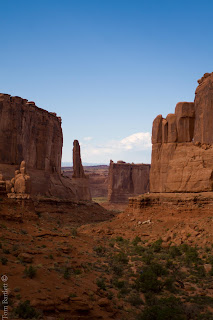Taking a road trip is a great way to see a country in your own terms. Driving the Historic Route 66 taught me a few things about how to get the most out of the experience:
1) Get a GPS
With a GPS, you can easily navigate the twists and turns of a new city on your own. If travelling with others, it gives you a third party to shout out when you get lost.
2) Use boxes to organize your stuff
Clearly labelled boxes in the boot of your car make sure that everything is where it should be when you need it. We had four boxes. One for food, one for cooking equipment and two for clothing. Plus rooting through a box is often easier than shuffling through a bag.
 |
| Fully packed |
3) Check the car, but don't obsess over it
The car we were in had a recent check-up and we had the oil changed and the tires rotated just before we left. Along the way we periodically checked the oil, coolant, and tire pressure.
4) Pack a tent
We had a lot of fun camping along the way. While sleeping in roadside motels is a part of the classic road trip, a tent increases our options. Plus looking out at the stars in the middle of the Mojave desert as you drift off to sleep is a priceless experience.
5) Stay Hydrated
Staying in a climate controlled, air conditioned car, concentrating on driving and singing along to the radio, it's easy to forgot that you need to keep drinking. Always have water handy, plus keep plenty spare if you're driving through dry regions. If your car breaks down, you'll be glad to have the water there.
6) Eat at least one healthy meal a day
It's easy to get lazy and live out of diners and drive-thru restaurants. Make the effort to have at a healthy meal a day. Your energy levels will be better, as will your health. Also try to have healthy snacks in the car. Snacking is a great way to keep your blood sugar levels constant so long as you're not chowing down on chocolate and twinkies (not tried one of these yet). But by all means, if you want the challenge of eating a
72 oz steak in under an hour, by all means, go for it.
7) Take regular breaks
If you're drinking regularly, you'll have to stop. Plus a short break every two hours makes sure you don't make any silly mistakes and keeps the driving interesting. Plus, there's always some
roadside attraction that's sure to grab your interest.
8) Bring music
While the radio offers some fantastic listening (thank you
Bob FM) there will be points of the journey when all you get is static. Time to plug in your ipod, insert a CD or roll out a cassette. A variety of tunes is a must. Your 1996 classic
Now 34 CD will get old pretty quick.
9) Budget
With regular breaks at expensive petrol stations, curio shops and various unforeseen road tolls (I'm looking at you, Oklahoma) it is easy to let your spending get away from you. I find that it helps to write down exactly how much you spend on what. It's pretty easy to see that if things are getting tight, then spending $5 a day on beef jerky might not be such a good idea.
10) Save fuel
Here's a little sub-list of fuel saving tips:
- Don't speed: driving slower speeds can increase fuel efficiency by up to 5%.
- Keep rolling: pulling away from a dead stop uses more fuel, so try to predict when those red lights will turn green.
- Pack light: a little obvious this one, plus keep it in the car. Roof boxes greatly increase your car's drag.
- Coast: on empty hills, slip the car into neutral and let gravity do the work, just remember to put it back into gear at the bottom.
If you have any tips of your own, please share!



















































